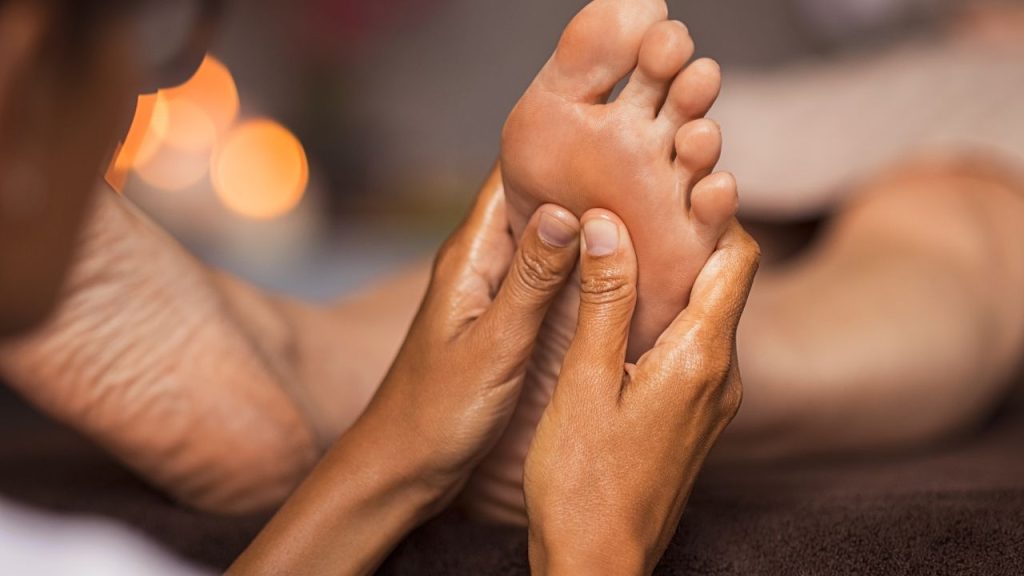Introduction to Reflexology
Reflexology is a powerful healing technique that has been practiced for centuries. It is based on the principle that there are reflex points on the feet, hands, and ears that correspond to every part, organ, and system of the body. By applying pressure to these reflex points, reflexologists stimulate the body’s natural healing abilities, promoting balance and well-being.
History and Origins of Reflexology
Reflexology has a rich history that dates back thousands of years. Ancient civilizations such as the Egyptians, Chinese, and Native Americans recognized the healing power of touch and used reflexology to treat various ailments. The modern practice of reflexology, as we know it today, was developed in the early 20th century by Eunice Ingham, who mapped the reflex points on the feet and created a systematic approach to reflexology.
How Reflexology Works

Reflexology works on the principle that the reflex points on the feet, hands, and ears are connected to specific organs, glands, and body systems. By applying pressure to these reflex points, reflexologists stimulate the corresponding areas in the body, promoting circulation, relaxation, and the release of tension. This stimulation activates the body’s natural healing response, helping to restore balance and harmony.
Benefits of Reflexology
Reflexology offers a wide range of benefits for both physical and mental well-being. It can help reduce stress and anxiety, improve circulation, relieve pain and discomfort, boost the immune system, and enhance overall relaxation. Reflexology is also known to promote better sleep, improve digestion, and support detoxification. Many people find reflexology to be a deeply relaxing and therapeutic experience, providing relief from the demands of daily life.
Understanding the Purpose of Reflexology
The purpose of reflexology is to bring the body back into a state of balance and harmony. It works holistically, addressing not only the symptoms but also the underlying causes of imbalance. Reflexology helps to stimulate the body’s self-healing mechanisms, supporting the body’s natural ability to heal itself. It is a non-invasive and gentle therapy that can be used as a standalone treatment or in conjunction with other healthcare modalities.
Who Should Not Get Reflexology
While reflexology is generally safe for most people, there are certain situations where caution should be exercised. Pregnant women in their first trimester should avoid reflexology, as it can potentially stimulate the uterus and cause contractions. People with certain medical conditions such as deep vein thrombosis, foot ulcers, or open wounds should also avoid reflexology. Additionally, if you have any concerns or medical conditions, it is always recommended to consult with a qualified healthcare professional before undergoing reflexology.
Common Conditions Treated by Reflexology
Reflexology can be used to address a wide range of health conditions. It is commonly used to relieve stress and anxiety, reduce pain and inflammation, improve digestion, enhance sleep quality, and support overall well-being. Reflexology has also been shown to be beneficial in managing conditions such as migraines, hormonal imbalances, respiratory disorders, and musculoskeletal issues. Many people find reflexology to be a valuable complementary therapy in their overall healthcare regimen.
Exploring the Three Types of Reflexology
There are three main types of reflexology: foot reflexology, hand reflexology, and ear reflexology. Foot reflexology is the most common and widely practiced form of reflexology. It involves applying pressure to specific reflex points on the feet to stimulate the corresponding areas in the body. Hand reflexology follows a similar principle but focuses on the reflex points on the hands. Ear reflexology, also known as auricular therapy, uses the reflex points on the ears to promote healing and balance in the body.
Reflexology Techniques and Practices
Reflexologists use various techniques and practices to deliver the benefits of reflexology. These techniques include thumb and finger pressure, kneading, stretching, and rotation. Reflexologists may also incorporate the use of essential oils, hot stones, or other tools to enhance the therapeutic effects of the treatment. Each session is tailored to the individual’s needs and preferences, ensuring a personalized and effective healing experience.
Conclusion: Harnessing the Healing Power of Touch with Reflexology
Reflexology is a powerful healing modality that harnesses the natural healing power of touch. By stimulating the reflex points on the feet, hands, and ears, reflexologists can promote balance and well-being throughout the body. Reflexology offers a multitude of benefits, from reducing stress and anxiety to improving circulation and relieving pain. It is a safe and non-invasive therapy that can be enjoyed by many, with caution exercised in specific situations. Whether used as a standalone treatment or as part of a comprehensive healthcare approach, reflexology has the potential to enhance physical and mental well-being, bringing the body back into a state of harmony and vitality.
If you are interested in experiencing the healing power of reflexology, I encourage you to find a qualified reflexologist near you. Take the first step towards a balanced and harmonious life today.